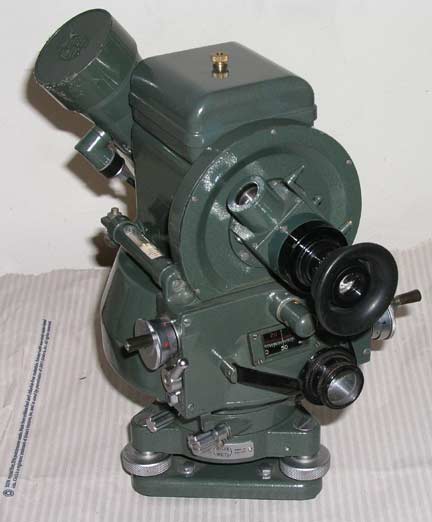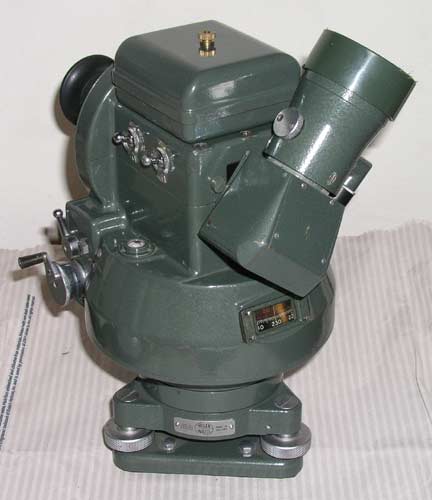Hilger and Watts Ltd., London MK V Balloon Theodolite also known as SM1.
This is the final example in a series of theodolite that is the standard in the meteorological services of the British Commonwealth. They were designed at the Meteorological Office in collaboration with E. R. Watts & Son LTD. and production was continued under Hilger and Watts LTD after the merger in 1948. Production was licensed to Clarkson from the late 1970's through 1983 This model was recently available from Hall & Watts Defense Optics. While this theodolite does not appear on their website as of 9-2009 it may be available by special order. The Mk V theodolite is very similar to the Watts MK IIII. The Mark V has a more modern finish and tribrach assembly, it is manufactured with some upgraded materials as well. The Mark V adds a window in the rear of the unit where the circles can be read. Other changes from the MK IIII include the relocating of a bubble level from the top of the tribrach base to the body of the theodolite, and the addition of a key lock on the wood case of the instrument. The instrument pictured, produced in 1968, was in the service of a British Military Unit.
In common with other land based balloon theodolites the Watts MK V has a telescope with a bent optical axis. A secondary wide-angle telescope using the same eyepiece is selectable with a mirror. There are two pins on the tip of this instrument that serve as contacts to an attachable battery case. The photo shows the theodolite with the battery case attached. Follow this link for a more detailed description and Cutaway Illustration of the Watts Balloon Theodolite.
This theodolite incorporates a lined gradicule to support the tail method of altitude determination. The Met. Office also utilized a slide rule for obtaining wind data from observations made with this theodolite. See also Met. Office Pilot Balloon Filler and Weight Set.
 |
 |
In the photo above you can see the bubble level directly under the two switches. The switches control illumination of the reticule and the circles. The reticule illumination level is further adjusted by rotation a knob connected to a small mirror in the objective (an unusual system - not utilizing a rheostat). You can see the accessories for this instrument, filters for the eye piece, the key to the case, lens shade, lens cap and a plumb bob. Also note the hook for hanging a stopwatch and the magnifying glass to assist reading the circles.
The gun site for rough tracking is under the finder scope in this photo (you would not
usually start an observation with the theodolite in this position).
| Drive Type | Positively Engaging Tangent Screw | Compass | No |
| Display Type | Micrometer .1 degree | Levels | 1 Inst body plate circular, 1 Inst, body bubble tube |
| Main Telescope | 40 mm 16x 2deg. | Mounting | Tribrach |
| Finder Telescope | 12.5mm
4.5x 8deg. single eyepiece |
Illumination | 2, 3
Volt lamps, scales reticule |
| Gun Site | Yes 1, on finder telescope | Weight (theodolite only) | 8.4 kg |
